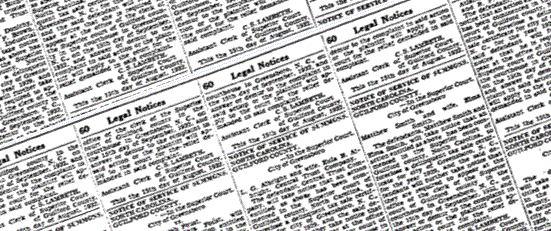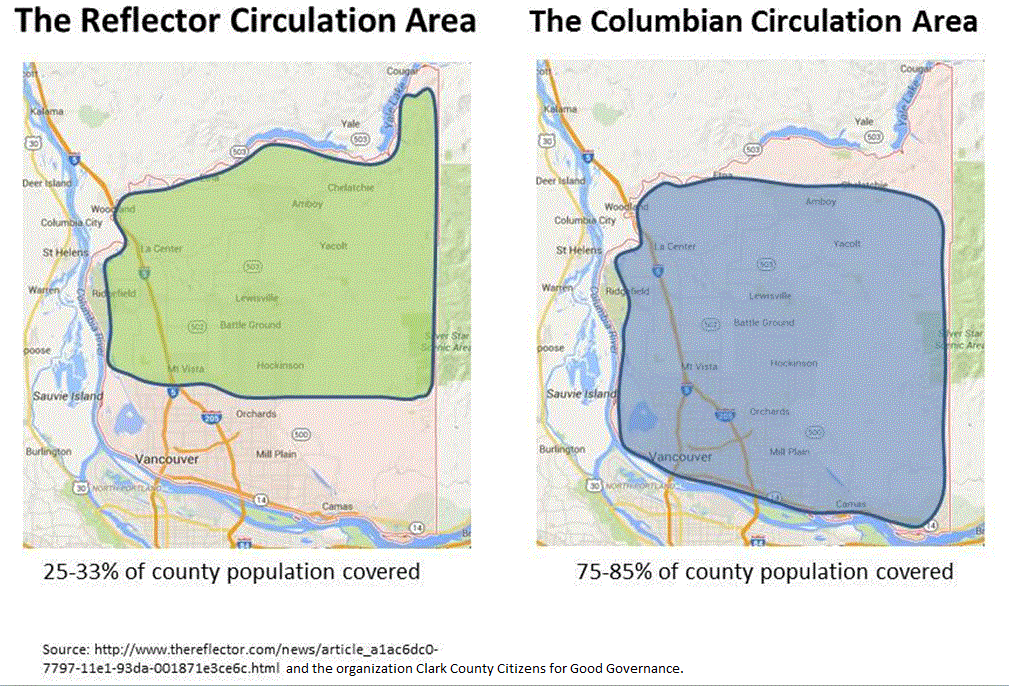
They say that if you’re taking a lot of flak, you know you’re over the target. The amount of effort being devoted to justifying the nonsensical and corrupt decision to award the paper of record contract to a paper that’s half again as expensive with a lower circulation is bordering on the hysterical. We at ClarkCounty.info previously pointed out the logical problems with this decision, but we made the mistake of doing so in a way that required a degree of inference, logic and objective thinking. We know that most of our readers get it and understand. But the cult-like supporters of the Clark County establishment, personified by Marc Boldt and his cronies on the County Council, continue to obfuscate the issue with flawed logic and inaccurate claims based on perception,  emotion, and lies, rather than things like, you know, facts. This group of true believers seeks to steer the public perception with the age-old tactic: If you repeat a lie long enough, it becomes truth.
emotion, and lies, rather than things like, you know, facts. This group of true believers seeks to steer the public perception with the age-old tactic: If you repeat a lie long enough, it becomes truth.
This article is going to address the misinformation, non sequiturs, and logical absurdities of the establishment claims. The latest arguments in support of the Columbian as paper of record include a coverage map of the distribution of the Reflector and the Columbian. The argument goes that the Columbian is available to a larger population than is the Reflector. The number cited is that the Reflector serves only 25-30% of the population.
Let’s look at the facts.
Fact: The price of legal advertising in the Reflector is $1.02 for the first insertion and $0.84 for subsequent insertions. The price of legal advertising in the Columbian is $1.77 for the first insertion and $1.45 for subsequent insertions. These numbers are from the contract bid presented to the council board by the county Purchasing Manager. They’re an objective fact, and they’re not in dispute, despite shrill claims that they’re “made up,” or a lie.
Fact: The Reflector ’s circulation is 28,218. The Columbian’s circulation is 24,152. The bid presented to the council by the Purchasing Manager erroneously listed the Columbian circulation as 27,152. This error was corrected by the county Purchasing Manager in his testimony when he presented the bid to the council. These numbers are a fact, and they are not in dispute. Nevertheless, the advocates for the Columbian use the incorrect, higher number for their arguments, even after admitting that they were physically in the room when the bid was presented and knowing full well that the number was off by 3,000. This shows a willingness to resort to dishonesty to justify their position.
Fact: Both the Columbian and the Reflector meet the minimum requirements as a legal newspaper. This is a fact, and it is not in dispute. Examples were made that in the past a more expensive towing service was selected for the Sheriff’s office. This is a distortion of the facts to fit the narrative, because the lowest bidder (Action Towing and Custom Towing) was determined to be unqualified for the contract because they did not meet the specified requirements. In choosing the paper of record, the Reflector does meet the specified requirements.
Fiction: Claims have been made that the Columbian has a weekly circulation of almost 200,000. This logical fallacy is based on the fact that the Columbian is a daily paper. 24,152 x 7 = 169,064. You can see this misses the mark of 200,000 by a significant margin, which is the first indication that this is propaganda, that they would be fast and loose with such an opportunistic rounding decision. The question is how many people have access to the legal notices in each paper? Even if legal notices were published over seven consecutive days in the Columbian, they would still reach the same number of households, 24,152, and still be seen by the same number of eyes. The logical fallacy here is trying to make the case that production equals circulation. Being a daily paper doesn’t mean more people have access to the legal notices. It means that fewer people get more papers.
Fiction: Some claimed that the Columbian’s internet presence is significantly higher, with more views than the Reflector, so the Columbian has a wider internet circulation. This is not in dispute, but it has nothing to do with the question at hand for a variety of reasons:
— The Revised Code of Washington (RCW) says nothing about digital media.
— The larger number of hits on the Columbian’s website has nothing to do with legal notices.
— The number of people with access to the online legal notices of the Reflector is precisely identical to those who have access to the same of the Columbian. The idea that the online presence of one paper is superior to that of another paper has no merit. If you have the link, you have the notices, regardless of which paper’s server hosts them. Papers provide online legal notices as a courtesy. These notices are also provided by the county government website, at no cost to the taxpayer.
Again, this argument is propaganda, without merit, intended to confuse the unwary and make the cult members feel good, so they may continue chanting this twisted point of view.
Fiction: Councilor Olson observed that when the Reflector was the paper of record, the County spent more on legal advertising that it did when the Columbian was the paper of record. Her cult followers began chanting this refrain. This claim is not in dispute. The conclusions that the establishment apologists draw from this are fraught with logical errors and inconsistencies.
The first problem with the conclusion that it’s more expensive in the long run to advertise in the Reflector is that the comparison in question makes no account for the volume of advertising purchased. No records are available to determine if the volume was comparable or greater for the year that the Reflector was the paper of record. If there were sufficiently more advertisements placed, of course the cost would be higher.
The case was made that some announcements concerned parts of the County population not served by the Reflector, so required that they be published in multiple newspapers, thus increasing the cost. The graphic here is supposed to make a powerful statement, but it only works if you give it more significance than it’s due, because it neglects to show that a paltry 15% of all households in the
Columbian service area actually get the Columbian, as opposed to 62% of the households in the Reflector’s service area getting the Reflector. This argument has further flaws, as we’ll prove.
 We can divide legal advertisements into two categories: Those which require publication in multiple papers and those that do not.
We can divide legal advertisements into two categories: Those which require publication in multiple papers and those that do not.
For those advertisements that do not need to be published in multiple papers, the calculus is simple. The Columbian will cost 57% more than the Reflector. When you factor in the distribution, this means the Columbian is twice the price for every potential view as is the Reflector. The claim was made that the Reflector ’s area of coverage only encompasses 25-30% of the county’s population. This is reasonably accurate, but neglects to mention that 54% of the County’s population lies in the incorporated sections of Vancouver, Camas and Washougal. These people have little interest in County legal notices, as they’re under municipal jurisdiction.
For those advertisements that do need to be published in multiple papers, it makes no difference if the paper of record is the Columbian or the Reflector. If a legal notice is important enough that it needs to be seen by a wider population than that served by the Reflector, it only stands to reason that it’s important enough to be seen by a wider population than that served by the Columbian.
Let’s just say, for the sake of discussion, that everyone who gets the Columbian also gets the Reflector. This is an absurd assumption, since 3/4 of the households who get the Columbian don’t live in the Reflector’s service area, but the one thing that’s irrefutable is that at least 4066 households who get the Reflector don’t get the Columbian. It doesn’t matter where these people live. This number is probably more like 20,000, based on the populations of the areas of coverage and the percentage of households who get each paper.* Now, if a legal notice is important enough to publish in the Columbian to reach a wider audience if the Reflector is the paper of record, why doesn’t the reverse hold true? Why, if the Columbian is the paper of record, is it permissible to ignore the 4,000 (possibly 20,000+) people who get the Reflector and not the Columbian for a notice that requires higher distribution? This is probably what happened when the Columbian was the paper of record, which is why, again, the comparison between the expenses is without merit. No responsible public servant can make the case that it’s not necessary to publish notices in the Reflector even if the Columbian is the paper of record, because it doesn’t matter if the 4,000 – 20,000+ people who get the Reflector but not the Columbian don’t get legal notices. If it’s necessary to print to the Columbian to reach 17,000 or so households that wouldn’t be reached by the Reflector, it’s equally necessary to print to the Reflector to reach the 21,000 or so households that wouldn’t be reached by the Columbian. The cost is a wash, regardless of which is the paper of record, unless the majority of the County Council can justify ignoring the North County citizens. And why not? They overwhelmingly didn’t vote for downtown establishment councilor majority anyway.
You could argue that those people have access to the Columbian, so they could get it if they wanted. This ignores that the Reflector is free in the service area, and the Columbian costs $1 an issue. It also ignores that the Columbian only serves 15% of the households in the county. What of the other 85% who may want to get legal notices? The fact is that if you want to get legal notices, you have to buy a copy of the Columbian, wherever you are. If the Reflector is the paper of record and you wanted legal notices and were outside the service area, you could still buy a copy of the Reflector to be delivered, for the same price per issue as the Columbian – a net savings, because the Reflector only publishes once a week.
If this was a problem, someone would have complained, and those complaints would be shoved under our noses by the advocates of the Columbian award as proof. No such complaints have been lodged, and the answer is simple: get the Reflector. Or join the 21st Century and read the notices online – where they’re easier to read anyway.
Fiction: Because the Reflector is a weekly paper, it interferes with the county business. A case is cited where a Planning Commission Hearing had to be rescheduled because of a technical error that prevented the proper notice from being in the Reflector, and it took a week for the correct notice to be printed. The evidence presented for this was an article published by. . . .the Columbian. Gee, you wouldn’t think they would have a reason to put that in as poor a light as possible, would you? This is an exception, a singular occurrence, and hardly justifies paying a competitor 57% more. If daily publication was a requirement, then the Reflector would have been disqualified as not meeting the requirements. It was not, because no such requirement exists.
To recap: The Reflector costs less and serves more people in Clark County. It meets the requirements specified by the Revised Code of Washington (RCW). Daily publication isn’t the same as increased circulation. Web presence is a nonissue, because anyone can click a link, it doesn’t matter which paper that link leads to. When multiple papers must be used to increase the outreach, responsible governance says that it doesn’t matter who the paper of record is.
Awarding the paper of record to a more expensive publication with a lower circulation is fiscally irresponsible. It does not serve the Clark County citizens. This action’s sole purpose is to financially reward the Columbian for its support of the establishment politicians and bureaucrats and damage it inflicts on the opposition. This is unapologetic cronyism and corruption right out in the light of day. The Councilors who voted for this travesty should hang their heads in shame. Their all too vocal supporters who chant the talking points and refuse to answer the logical deficiencies of their arguments should be embarrassed.
*There are 158099 households in Clark County according to the latest numbers. With a circulation of 24152, that means 15.3% of households receive the Columbian. Assume for discussion that this is evenly distributed across the county. There are approximately 45,450 households in the area services by the Reflector, based on the number of voting precincts in that area. 15.3% of 45450 is 6954 households who probably receive the Columbian in this area. If you assume that all of these also get the Reflector, that still leaves 21,264 households which get the Reflector but not the Columbian.
This action’s sole purpose is to financially reward the Columbian for its support of the establishment politicians and bureaucrats and damage it inflicts on the opposition.
